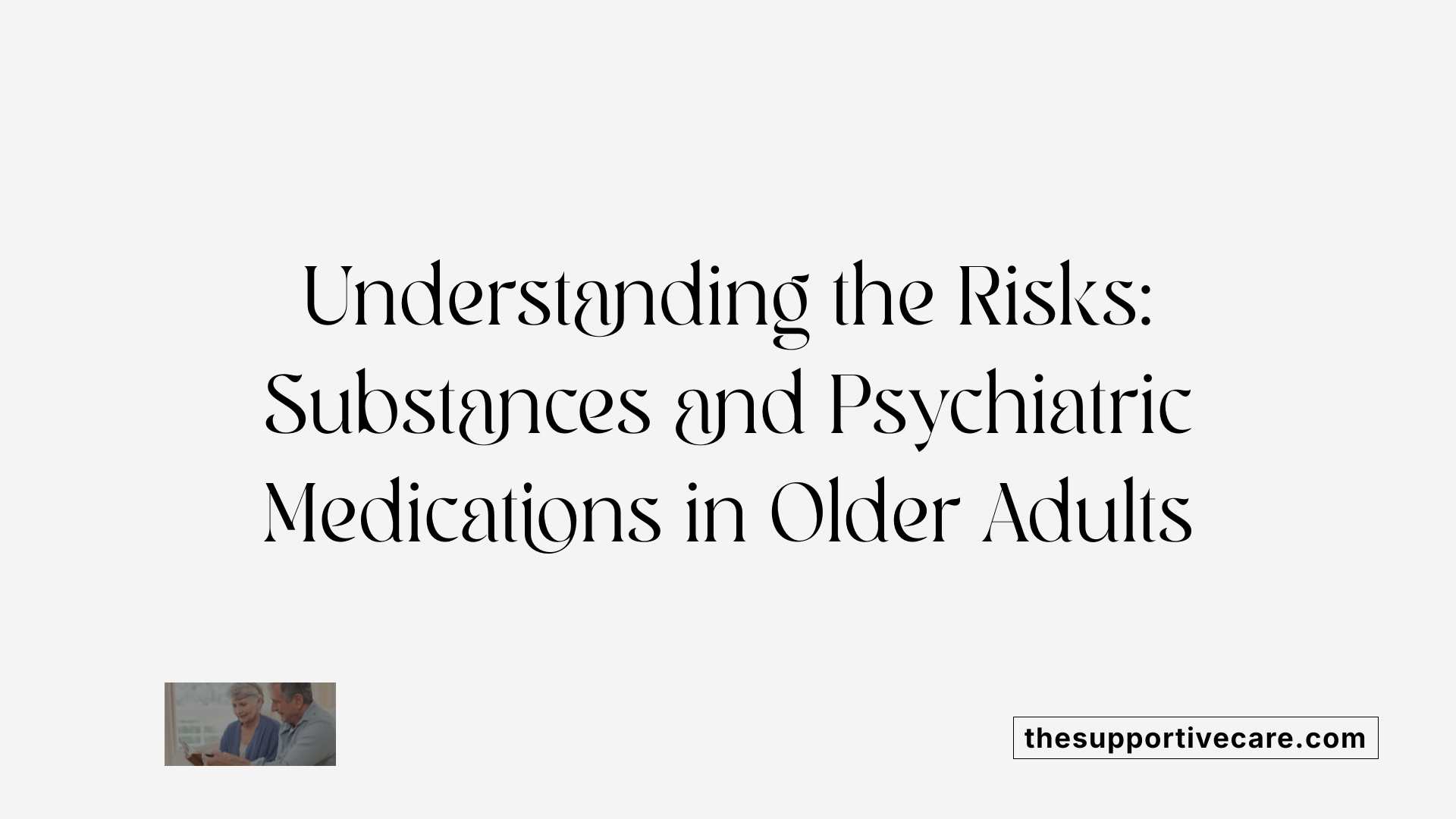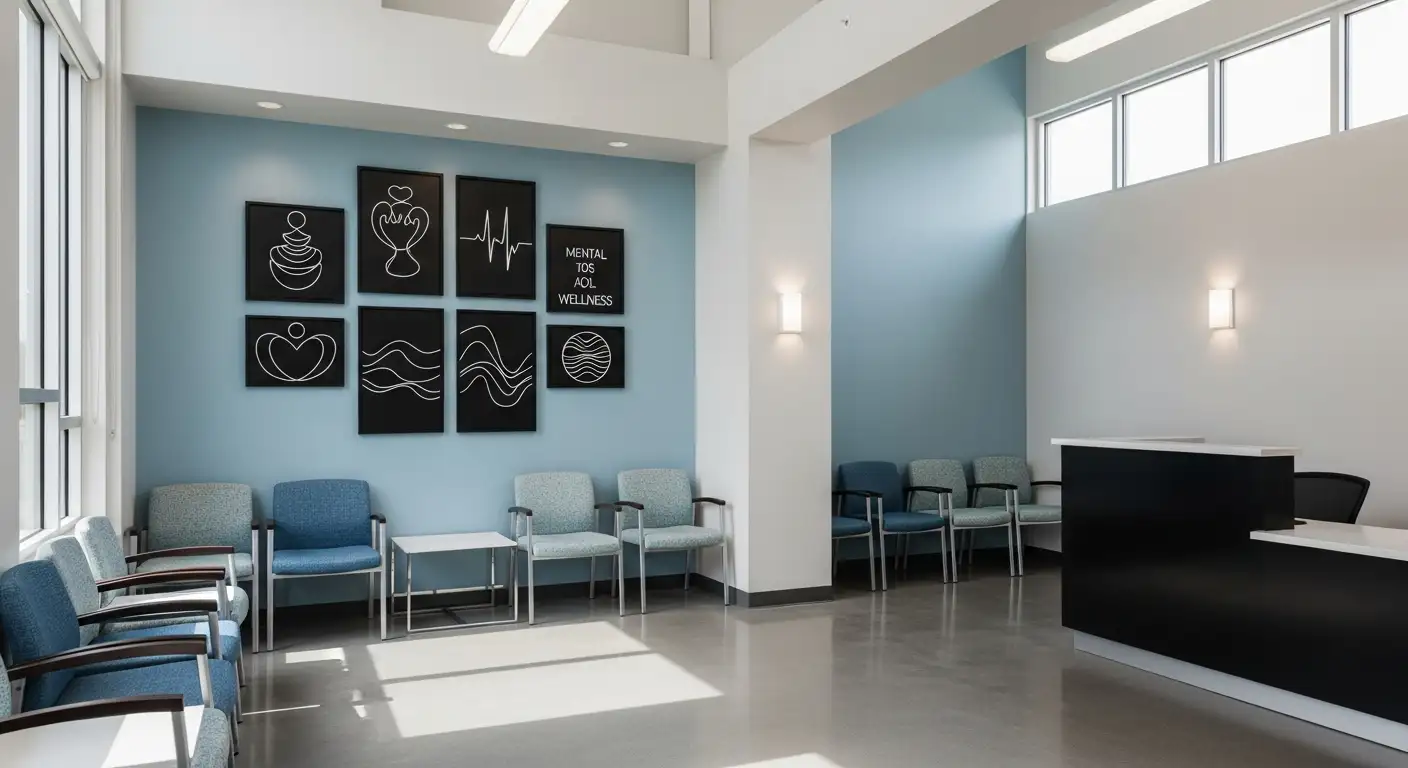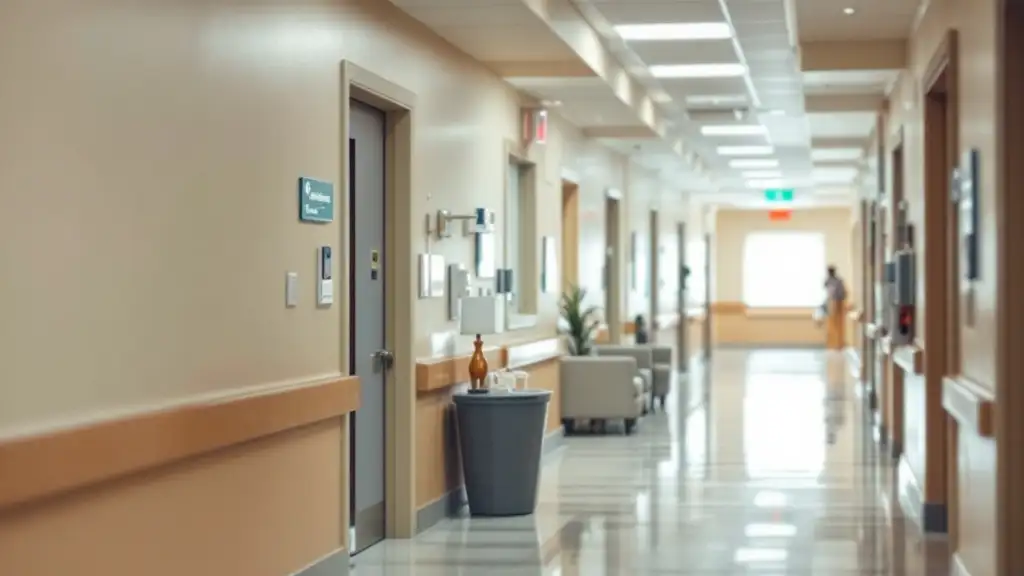Understanding the Growing Challenge
Substance use disorders and psychiatric medication misuse among older adults represent a rising public health concern, driven by an aging population with changing patterns of substance use, co-morbidities, and physiological vulnerabilities. This article explores the risks associated with psychoactive medications and illicit substances in geriatric populations, discusses the challenges of diagnosis and treatment, and highlights comprehensive, evidence-based approaches tailored to the unique needs of older individuals.
Prevalence and Changing Patterns of Substance Use Among Older Adults
What are the common substances of misuse among older adults and how are patterns changing?
Substance use disorders (SUDs) among older adults have been on the rise, marked by increasing admissions to treatment programs and heightened use of multiple substances. Alcohol remains the most prevalent substance, with many older adults engaging in binge and heavy drinking, particularly women. Alongside alcohol, cannabis use among this population has surged by about 75% between 2015 and 2018, often driven by medicinal purposes like managing pain or sleep disturbances.
Opioid prescriptions have similarly increased, leading to more misuse and overdose deaths in older adults. Benzodiazepines are commonly used for anxiety and sleep disorders, but their misuse has also escalated, raising concerns about cognitive impairment and dependence. Cocaine use, although less widespread, is growing and associated with serious cardiopulmonary and psychiatric complications in older adults.
The baby boomer generation—those born from the mid-1940s to mid-1960s—significantly influences these trends due to their comparatively higher rates of alcohol and psychoactive medication misuse compared to earlier generations. Their exposure to changing social norms and evolving drug laws has contributed to early onset as well as persistence of substance use into later life.
Late-onset substance use is often triggered by stressors common in older age, such as medical illness, social isolation, and the loss of a spouse or loved ones. These factors highlight the complex interplay of psychological and social triggers that contribute to changing patterns of substance use among the elderly.
Older adults' substance misuse is frequently underreported or mistaken for normal aging or medical conditions, underscoring the need for improved screening and targeted interventions in healthcare settings.
Physiological Changes in Aging that Impact Medication and Substance Risks
How do physiological changes with aging affect psychiatric medication and substance use risks?
As people age, the body undergoes several biological changes that significantly influence how medications and substances are processed and tolerated. One major change is the decreased function of the liver, which slows hepatic metabolism. This results in medications and substances remaining in the body longer, causing higher blood concentrations and increasing the risk for toxicity.
Additionally, aging leads to alterations in body composition, such as decreased muscle mass and increased fat stores. These changes affect the distribution and storage of drugs, especially those that are fat-soluble, potentially intensifying their effects or side effects.
The permeability of the blood-brain barrier increases with age, making the central nervous system more vulnerable to substances like alcohol, benzodiazepines, and psychoactive medications. This heightened sensitivity can contribute to cognitive decline, greater sedation, and increased risk of falls.
Together, these physiological shifts heighten the likelihood of adverse drug reactions, dangerous interactions with multiple medications, and more severe consequences from substance misuse. For older adults using psychiatric medications or substances recreationally, these changes necessitate careful dosing, monitoring, and screening to minimize harm.
In summary, aging-related biological changes impair drug metabolism and increase susceptibility to the toxic effects of medications and substances, thereby elevating the risks of health complications in the geriatric population.
Risks Associated with Common Substances and Psychiatric Medications in Older Adults

What are the specific risks linked to common substances and psychiatric medications in geriatric populations?
Alcohol misuse remains the most prevalent substance issue among older adults and presents serious health challenges. Aging leads to biological changes such as decreased liver function and increased blood-brain barrier permeability, which heighten susceptibility to alcohol toxicity. This increases risks of intoxication, adverse interactions with other medications, cognitive decline, and exacerbation of cardiovascular conditions.
Cannabis use in the elderly is rising rapidly, often for medicinal reasons like pain relief and sleep improvement. However, increased THC potency raises concerns. Older adults who use cannabis face a higher risk of falls, cardiovascular complications, psychiatric disorders, and impairment, especially when combined with other substances.
Opioids continue to be misused by older adults, with overdose deaths increasing dramatically. Age-related changes affect opioid metabolism, making this population more vulnerable to adverse effects. Treatment with methadone or buprenorphine is effective but requires cautious dosing and close monitoring to prevent harm.
Benzodiazepines are commonly prescribed for anxiety and sleep disturbances but carry significant risks for the elderly. Their use is linked to cognitive impairment, dependence, increased fall risk, and potential associations with dementia. Alternative treatments such as cognitive behavioral therapy are recommended to avoid these complications.
Collectively, these substances contribute to a heightened risk of falls, fractures, cognitive decline, cardiovascular complications, and psychiatric issues among older adults. Given these compounded risks, routine screening and culturally sensitive interventions are critical to safeguard geriatric health.
Challenges in Identifying Substance Misuse and Psychiatric Medication Risks Among Older Adults

Why is substance misuse and psychiatric medication risk often overlooked in older adults, and what tools aid identification?
Identifying substance misuse and psychiatric medication risks in older adults is particularly challenging due to the overlap of symptoms with normal aging processes and chronic health conditions. Symptoms like cognitive decline, sleep disturbances, and mood changes may be mistakenly attributed to aging or existing diseases rather than substance use or medication effects.
Polypharmacy, common in this group, further complicates diagnosis as multiple medications interact and produce side effects mimicking substance misuse. Adding to this complexity, many healthcare providers do not routinely screen older patients for substance use disorders, partly due to stigma, limited training, and difficulty distinguishing symptoms.
To address these challenges, several validated screening tools are recommended for use in clinical settings. For alcohol misuse, these include AUDIT-C, CAGE, CARET, and MAST-G, which focus on consumption patterns, consequences, and risk factors among elderly populations. For drug use, tools like ASSIST and CAGE-AID help identify illicit and prescription drug misuse, including opioids and benzodiazepines.
Implementing routine, nonconfrontational screening with these instruments allows earlier detection of substance problems. Approaches such as motivational interviewing, combined with culturally sensitive care, can improve acceptance and referral to treatment. Ultimately, increasing healthcare provider awareness and standardized screening protocols are essential to better identify and manage substance misuse and psychiatric medication risks among older adults.
Comprehensive Treatment Services for Substance Abuse and Psychiatric Conditions in Older Adults

What comprehensive treatment services are available for substance abuse, mental health issues, and various forms of addiction?
Treatment for substance abuse and mental health conditions in older adults involves a multifaceted approach tailored to the unique needs of this population. Medical detoxification is often the first step, providing a safe environment for managing withdrawal symptoms under clinical supervision.
Following detox, individualized therapy options are critical. These include both individual and group therapies such as cognitive behavioral therapy (CBT), motivational interviewing, and contingency management. These approaches help address behavioral aspects of addiction and mental health challenges.
Medication management plays a vital role, especially for co-occurring psychiatric conditions. Prescribers must consider age-related changes in metabolism and drug sensitivity to optimize dosing and minimize side effects. Psychiatric evaluations are conducted to identify and treat conditions such as depression, anxiety, or cognitive impairments that often accompany substance use disorders in older adults.
Integrated care models provide the most effective framework by combining addiction treatment with management of physical and mental health conditions. These models ensure coordinated care across settings like primary care, addiction specialists, and geriatric services.
The Substance Abuse and Mental Health Services Administration (SAMHSA) has developed Treatment Improvement Protocol 26 (TIP 26), which offers evidence-based guidelines specifically designed for treating substance misuse in older populations. This protocol emphasizes approaches like motivational interviewing and CBT, as well as the importance of involving families and communities.
Specialized programs for older adults are available, including inpatient and outpatient services tailored to address aging-related challenges, chronic illnesses, and social factors such as isolation. These programs integrate therapies to support relapse prevention and long-term recovery while maintaining overall health and functioning.
These comprehensive services form a continuum of care that addresses the complex interplay of addiction, mental health, and aging, improving outcomes and quality of life for older adults struggling with substance use disorders.
Medication-Assisted Treatment (MAT) and Age-Related Considerations in Opioid Use Disorder
How is Medication-Assisted Treatment used in older adults with opioid use disorder and what are key management considerations?
Medication-Assisted Treatment (MAT) employs methadone, buprenorphine, and naltrexone to effectively reduce opioid misuse and lower overdose risks in older adults with opioid use disorder (OUD). These FDA-approved medications help stabilize brain chemistry, decrease cravings, and support recovery.
Age-related physiological changes—such as decreased hepatic metabolism and altered drug clearance—require careful dose adjustments and vigilant monitoring to minimize adverse effects. Older adults often experience increased sensitivity to medications, raising the importance of personalized dosing strategies.
Despite MAT's effectiveness, older adults face notable barriers to accessing these treatments. Regulations often mandate in-person evaluations and restrict flexible dosing schedules, complicating the treatment process for those with mobility or transportation challenges. Reimbursement frameworks frequently favor traditional in-person services, limiting telehealth options that could improve access.
The COVID-19 pandemic prompted temporary policy changes allowing telemedicine for methadone monitoring, which, if maintained, could reduce logistical hurdles in MAT delivery for seniors.
Incorporating geriatric care principles—such as the 4Ms framework (Matters Most, Medication, Mentation, and Mobility)—into addiction treatment programs can better address the complex needs of older adults. This approach prioritizes maintaining function, managing co-existing health conditions, and delivering age-friendly care, which together improve treatment outcomes.
Overall, integrating MAT with geriatric-informed care models and tackling regulatory challenges is essential to optimize opioid use disorder management in the aging population.
Alternative and Complementary Approaches to Benzodiazepine Use in Older Adults
What are the risks of benzodiazepine use in older adults and what alternative management strategies exist?
Benzodiazepines are frequently prescribed to older adults for anxiety and sleep disorders but carry significant risks. These include cognitive impairment, dependence, increased risk of falls, and a potential link to dementia. Given the physiological changes in aging, such as slowed drug metabolism and heightened sensitivity to psychoactive substances, these risks are especially pronounced in this population.
Monitoring strategies involve regular assessment of the patient's medication use, cognitive function, and physical safety. Deprescribing — the gradual reduction and eventual cessation of benzodiazepines — is recommended when appropriate. It requires careful clinical supervision to minimize withdrawal symptoms and avoid relapse.
Non-pharmacologic alternatives provide promising options for managing anxiety and insomnia without the adverse effects associated with benzodiazepines. Cognitive Behavioral Therapy (CBT) is one such evidence-based approach that helps patients develop coping skills and improve sleep hygiene. Other supportive measures include relaxation techniques, mindfulness, and lifestyle modifications.
Education and support play a crucial role in managing benzodiazepine use. Informing patients and caregivers about the risks and benefits of these medications encourages informed decision-making and adherence to treatment plans. Support groups and counseling can further assist older adults in managing symptoms and reducing reliance on medication.
These strategies together optimize health outcomes by balancing symptom control with minimizing harm in older adults using benzodiazepines.
Addressing Social and Racial Disparities and Access Barriers in Geriatric Substance Use Treatment
How do social and racial disparities affect substance use disorder treatment access and outcomes among older adults?
Social and racial disparities profoundly influence the prevalence and management of substance use disorders (SUDs) in older adults. Marginalized populations, particularly Black men, show higher risk of opioid overdose and generally poorer outcomes due to limited access to culturally sensitive treatments and systemic inequities. Socioeconomic status also affects treatment initiation and completion rates, as resource constraints and social determinants hinder consistent care.
Structural barriers like ageism and stigma
Ageism and stigma within healthcare systems contribute to the underdiagnosis and undertreatment of SUD in the elderly. Older adults often do not receive routine screening or referrals for substance abuse treatment, partly due to prevailing misconceptions that substance misuse is uncommon in this group. These biases discourage seniors from seeking help and reduce provider engagement in delivering evidence-based interventions.
COVID-19 effects including social isolation
The COVID-19 pandemic intensified social isolation and stressors for older adults, triggering increased substance use. This isolation worsened mental health and complicated access to traditional treatment services. Simultaneously, pandemic-related disruptions highlighted the urgent need for adaptable care delivery models tailored to older adults’ unique challenges.
Emergence of telehealth as a solution
Telehealth has emerged as a critical advancement to bridge access gaps. Temporary policy changes during the pandemic enabled broader use of telemedicine for addiction treatments like methadone monitoring, improving reach for homebound or mobility-impaired seniors. If maintained, these regulatory flexibilities could transform care accessibility, overcoming barriers such as transportation difficulties and physical disabilities.
Health systems must prioritize culturally sensitive approaches and implement age-friendly strategies to ensure equitable SUD treatment access. Greater awareness, policy reforms, and technological integration are essential to addressing disparities and supporting recovery for older adults.
| Factor | Description | Impact on Older Adults' SUD Treatment |
|---|---|---|
| Racial/Socioeconomic Status | Influences risk, access, and completion of treatment | Marginalized groups face higher overdose risk and poorer outcomes |
| Ageism & Stigma | Leads to under-screening and undertreatment | Seniors less likely to be identified or referred |
| COVID-19 Pandemic | Increased isolation and stress, disrupted in-person care | Elevated substance use; need for adaptable treatment models |
| Telehealth | Expanded remote treatment options during pandemic | Improved accessibility, especially for those with mobility issues |
Screening, Early Intervention, and Preventive Strategies in Geriatric Populations
What screening and early intervention strategies are effective for managing substance misuse in older adults?
Routine screening for substance use in older adults is essential to identify misuse early, as symptoms often overlap with typical aging or medical problems. Healthcare providers should incorporate validated screening tools such as AUDIT-C and CAGE for alcohol, CARET and MAST-G tailored to older adults, and ASSIST or CAGE-AID for drug use detection.
Using nonconfrontational approaches like motivational interviewing helps address substance use sensitively, encourages openness, and respects cultural backgrounds. Culturally sensitive assessments improve detection and connection to care, especially important due to racial and socioeconomic disparities affecting this population.
Early brief interventions, including targeted education and counseling, can effectively reduce substance misuse and promote engagement in treatment programs. Providing older adults with information on the increased risks substances pose due to age-related biological changes supports prevention and timely healthcare involvement.
By routinely integrating these validated screening tools and culturally aware communication methods, healthcare settings can improve diagnosis rates and offer appropriate interventions such as cognitive behavioral therapy or motivational therapy. This comprehensive strategy fosters earlier detection and empowers older adults to pursue recovery pathways successfully.
Treatment Settings, Recovery Support, and Long-Term Management for Older Adults
What are the treatment and recovery support options available for older adults with substance use disorders?
Older adults experiencing substance use disorders benefit from a comprehensive spectrum of treatment options carefully adapted to their unique needs. Initial approaches often include medical detoxification to safely manage withdrawal symptoms under close supervision. Following detox, inpatient rehabilitation provides structured environments where older adults receive intensive care.
Outpatient programs offer flexible, ongoing treatment for those who require less intensive supervision or who are transitioning from inpatient care. Integrated care models are especially beneficial for older adults, addressing co-occurring medical and psychiatric conditions in a coordinated way. This holistic approach improves overall health outcomes by simultaneously managing chronic illnesses alongside addiction treatment.
Support groups, including age-specific meetings, play a crucial role in relapse prevention and sustained recovery by providing peer support and continuous engagement. These groups create community environments where older adults can share experiences and coping strategies, which is vital for maintaining long-term sobriety.
Insurance coverage significantly facilitates access to treatment. Most private insurance plans, including Medicare, cover addiction treatment for seniors due to federal regulations. This coverage ensures that older adults can access personalized, comprehensive care without facing prohibitive costs.
Addressing co-morbid health conditions during recovery
Many older adults face several chronic health issues alongside substance use disorders. Treatment plans are therefore designed to account for these co-morbidities, adjusting medication regimens and therapy modalities to minimize adverse effects and drug interactions. Integrating geriatric care principles ensures that treatments are safe, effective, and respectful of age-related vulnerabilities.
By combining medical treatment, psychological therapy, community support, and insurance-backed accessibility, recovery efforts for older adults are strengthened, greatly improving prospects for long-term wellness.
Future Directions: Integrating Geriatric and Addiction Care to Enhance Outcomes

What future strategies can improve management of psychiatric medication risks and substance abuse in older adults?
Addressing the rise of substance use disorders (SUDs) and psychiatric medication risks in older adults calls for a transformation in the healthcare system to deliver age-sensitive, comprehensive addiction care. Integrating geriatric care principles with addiction treatment is central to this transformation. Applying the 4Ms framework—Matters Most, Medication, Mentation, and Mobility—ensures that treatment programs not only focus on substance misuse but also prioritize the older adult’s overall well-being, cognitive health, and functional abilities.
Policy reforms are critical to improving medication access and reducing barriers. For example, loosening strict regulations around methadone and buprenorphine prescribing, alongside making telehealth services a permanent option, can enhance treatment accessibility, especially for older adults with mobility or transportation challenges. The COVID-19 pandemic demonstrated the benefits of remote monitoring and consultations, and sustaining these changes promises to expand care reach.
Continued investment in research and comprehensive data collection on substance misuse among older adults is essential. This will enable the development of evidence-based best practices tailored to geriatric populations, taking into account their unique physiological and psychosocial needs. Gathering behavioral health data specific to seniors helps clinicians recognize patterns, optimize screening tools, and refine intervention strategies.
Together, these strategies form a future-focused approach that acknowledges the complexities of aging, addresses health disparities, and supports recovery and quality of life in older adults facing substance use challenges.
A Path Forward for Safer Medication Use and Effective Treatment in Older Adults
The rising prevalence of substance misuse and psychiatric medication risks among older adults demands heightened clinical awareness, routine screening, and comprehensive, individualized treatment approaches. Incorporating geriatric principles, addressing disparities, and leveraging innovative care delivery such as telehealth will be critical to improve outcomes. By advancing policy, research, and patient-centered care, healthcare systems can better support the complex needs of aging populations and enhance safe medication management and recovery from addiction.
References
- Substance Use Disorders in the Geriatric Population
- Treating substance misuse in older adults
- Substance Abuse in the Elderly
- Prescription Medication Misuse and Abuse Among Older ...
- To Care For Older Adults With Substance Use Disorder ...
- Addiction Rehab for Seniors & Elderly Adults
- Treatment of Substance Use Disorders
- Home | SAMHSA - Substance Abuse and Mental Health ...
- Substance Abuse Services - Psychiatry



































































































